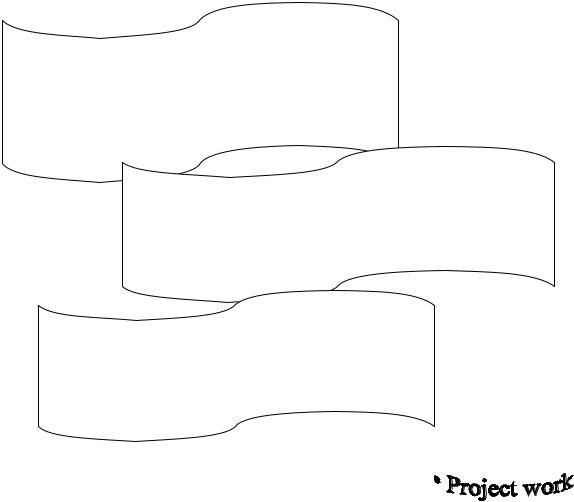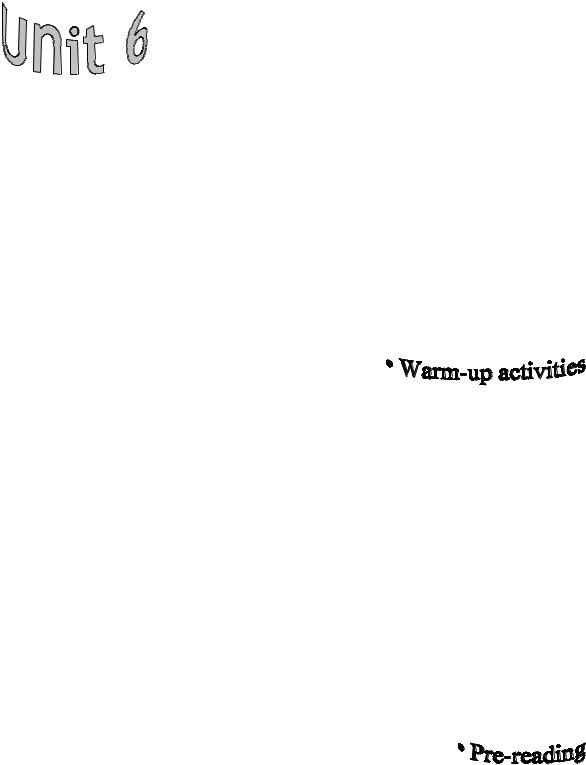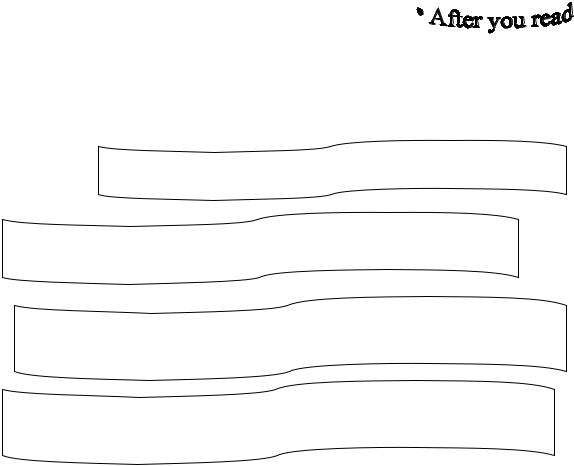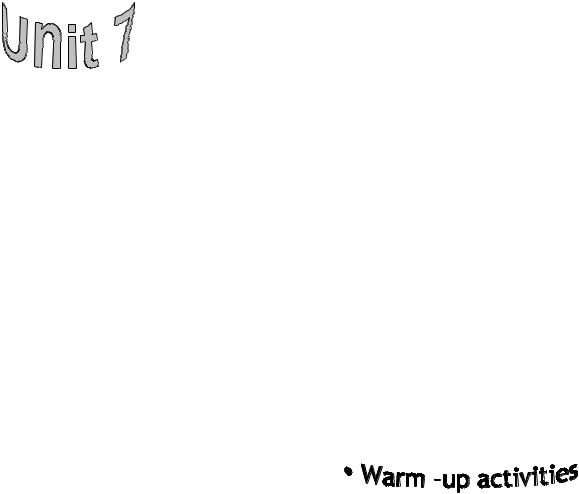
- •ФЕДЕРАЛЬНОЕ АГЕНТСТВО ПО образованиЮ
- •Рецензенты
- •Social Work: What is it?
- •10 Read the text below that reveals the problem of working conditions and earnings in the USA.
- •NASW Sponsors the SOS High School Suicide Prevention Program
- •NASW Endorses World Mental Health Day — October 10, 2004
- •For Immediate Release
- •February 23, 2004
- •NASW is Co-Sponsoring Partner of the “March for Women's Lives”
- •April 25, 2004 on the National Mall in Washington , DC
- •Social Security Policy
- •Disability
- •What is a ‘disability’?
- •10 Read the text that reveals one of the problems of disabled people and be ready to fulfil the tasks given after this text.
- •The 1995 Disability Discrimination Act
- •Organisations
- •Government
- •What can be done to improve the system of services for disabled people?
- •International Herald Tribune, 2001.)
- •Recovery from Traumatic Stress
- •(From: The Times, 2001.)
- •Money where their Mouth is
- •(By Robert M. Goodman, The Times, 2001).
- •15 Use additional sources (newspapers, magazines or Internet resources) to find the information about the events and foundations mentioned in the article ‘To Feed a Growing World Family, Fund Science for Farmers’:
- •Gates foundation
- •Kellogg foundation
- •McKnight foundation
- •16 Before reading the article that is called ‘Africans Are Ready for Bold Change, With Help’ make comments on the following statement:
- •“It is time that politicians and voters in reach countries realized that without a bright future for the poor, the future can’t be bright for the rest of the world.”
- •Africans Are Ready for Bold Change, With Help

7.Patients who have been discharged from hospitals may be placed on a ………. .
8.Under the Care Program Approach, mentally ill people should be assessed by specialist services, ………, and ……… should be appointed for each patient.
23 Answer the following questions and share your ideas with your partner.
oWhat are the advantages and disadvantages of
organising special educational institutions and educational programs for disabled people?
oIs there any special educational provision for disabled people in your country?
oCompare the system of educational provision and care and support services described in the passage with those that exist in your country.
oWhat can be done to improve the system of services for disabled people?
24 Use any sources of information available (newspapers, magazines or Internet resources) and carry out a project on any of the problems suggested below. You may fulfill this task in pairs or groups and consider the problem using the example of any English-speaking country.
oWhat educational and training opportunities are available for people with learning disabilities in your country?
oWhat kind of specialist assistance is provided for mentally disordered people in any English-speaking countries?
oWhat special hospitals or medical institutions for mentally disordered
people are there in your country? What problems do these institutions experience?
oWhat are the problems that people with learning disabilities suffer in special hospitals?
42

oWhat are the main problems that disabled people experience being out of work (emotional, financial, the problem of socialization and etc.)?
oSpeak on the organizations that deal with problems of employment of disabled people and their training.
oWhat are the reasons for launching a special system of financial provision for disabled people?
oDescribe the system of financial support in your country. Speak on the main problems that disabled people come across.
25 Write a composition giving your opinion on one of the statements below. Write your composition in 120 - 180 words.
oThe line from ‘normality’ to ‘abnormality’ is a continuum with no sharp cut-off point.
oThe greatest need for many people is to be accepted and not rejected as somehow ‘abnormal’.
oSchools could help young people by extending
community projects and encouraging young people to get to know disabled people.
oMany fears would be eliminated if disabled people were further integrated into the communities.
oThere is a tendency for the media to overdo the
‘tragedy’ aspect of disability. The media could play a role in changing attitudes by portraying people with a disability in everyday situations, leading a normal life.
Evaluation
1.What have you done in this unit?
2.What have you learnt from it?
3.What did you enjoy about it?
4.Have you any criticisms of it?
5.Have you any recommendations or suggestions for doing it differently?
43

Discrimination against Women: is it Really a Great Problem?
It's only women who are not really quite women at all, frivolous women who have no idea, who neglect repairs.
Duras, Marguerite,
French Author, Filmmaker
…………………………………………………………………………………
1 Discrimination against women – what is it? Think about the topic and fill in the drawing below.
Discrimination
against women
2 |
your attitude to this problem (discrimination against |
|
women)? Does it really exist in morden society? |
3 |
Make comments on the quotation given at the beginning of this unit. |
44

4 Study these survey results (UK, 2003). How would you answer the survey question given below? Discuss your responses within your group.
Do you think it is easier to be a man or a woman?
|
Females |
Males |
To be a man |
30% |
21% |
To be a woman |
59% |
65% |
5 Ask five women and five men outside the classroom the survey question and present your results to the class.
6 You are going to read a text which contains examples of the discrimination against women in different parts of the world. Some parts from the text have been removed.
A. In the U.S.A., students discriminate and attack girls in school who are lesbian, bi-sexual, or transgendered, or do not conform to male standards of female behavior.
B. We live in a world in which women do not have basic control over what happens to their bodies. Millions of women and girls are forced to marry and have sex with men they do not desire.
C. Men in Pakistan, South Africa, Peru, Russia, and Uzbekistan beat women in the home at astounding rates, while these governments alternatively refuse to intervene to protect women and punish their batterers or do so haphazardly and in ways that make women feel culpable for the violence.
D. Doctors and government officials disproportionately target women from disadvantaged or marginalized communities for coercive family planning policies.
E. Arguments that sustain and excuse these human rights abuses - those of cultural norms, "appropriate" rights for women, or western imperialism - barely disguise their true meaning: that women's lives matter less than men's.
Because I'm Worth it!
45

Millions of women throughout the world live in conditions of abject deprivation of, and attacks against their fundamental human rights for no other reason than that they are women. Combatants and their sympathizers in conflicts, such as those in Sierra Leone, Kosovo, the Democratic Republic of Congo, Afghanistan, and Rwanda, have raped women as a weapon of war with near complete impunity. ____1____ As a direct result of inequalities found in their countries of origin, women from Ukraine, Moldova, Nigeria, the Dominican Republic, Burma, and Thailand are bought and sold, trafficked to work in forced prostitution, with insufficient government attention to protect their rights and punish the traffickers. In Guatemala, South Africa, and Mexico, women's ability to enter and remain in the work force is obstructed by private employers who use women's reproductive status to exclude them from work and by discriminatory employment laws or discriminatory enforcement of the law.
____2____Women in Morocco, Jordan, Kuwait, and Saudi Arabia face government-sponsored discrimination
that renders them unequal before the law - including discriminatory family codes that take away women's legal authority and place it in the hands of male family members - and restricts women's participation in public life.
Abuses against women are relentless, systematic, and widely tolerated, if not explicitly condoned. Violence and discrimination against women are global social epidemics, notwithstanding the very real progress of the international women's human rights movement in identifying, raising awareness about, and challenging impunity for women's human rights violations.
____3____Women are unable to depend on the government to protect them from physical violence in the home, with sometimes fatal consequences, including increased risk of HIV/AIDS infection.
46
Women in state custody face sexual assault by their jailers. Women are punished for having sex outside of marriage or with a person of their choosing (rather than of their family's choosing). Husbands and other male family members obstruct or dictate women's access to reproductive health care.____4____Our duty as activists is to expose and denounce as human rights violations those practices and policies that silence and subordinate women. We reject any law, culture, or religion in which women are systematically discriminated against, excluded from political participation and public life, segregated in their daily lives, raped in armed conflict, beaten in their homes, denied equal divorce or inheritance rights, killed for having sex, forced to marry, assaulted for not conforming to gender norms, and sold into forced labor.____5____
Cultural relativism, which argues that there are no universal human rights and that rights are culture-specific and culturally determined, is still a formidable and corrosive challenge to women's rights to equality and dignity in all facets of their lives.
The Women's Rights Division of Human Rights Watch fights against the dehumanization and marginalization of
women. We promote women's equal rights and human dignity.
The realization of women's rights is a global struggle based on universal human rights and the rule of law. It requires all of us to unite in solidarity to end traditions, practices and laws that harm women. It is a fight for freedom to be fully and completely human and equal without apology or permission Ultimately, the struggle for. Women's human rights must be about making women's lives matter everywhere all the time. In practice, this means taking action to stop discrimination and violence against women.
(From: Newsweek. September 22, 2003.)

7 Divide the text above into logical parts and give them each a title.
8Prepare a summary of the text.
9Give a direct translation of the underlined part of the text.
10Look at the words in bold in the text above and try to explain
them.
11Cross the odd word out.
A. Discrimination |
Glass ceiling |
Sexism |
Rights |
B. Gender |
Violence |
Massacre |
Humiliation |
C. Charity |
Contribution |
Human rights |
|
12 Make comments on the following statements:
oUnkindness is death to the home. One unkind, unsocial, critical, eternally dissatisfied member can destroy any family.
oBeauty is unbearable, drives us to despair, offering us for a minute the glimpse of an eternity that we should like to stretch out over the whole of time. (Camus Albert, 1913-1960, French Existential Writer).
47

13 Look through the questions below and share your ideas with your partners:
What do you think governments should do to prevent discrimination in our society? What is the role of social workers on this issue?
What organizations do you know that provide aid and support to women and work for the emotional and physical relief of people involved in troubles?
What can we do as individuals to help and improve the situation of victims of discrimination?
14 Find information about different types of discrimination against women in modern Russia. Prepare a report about this isssue and suggest your own solution to this problem.
Evaluation
1.What have you done in this unit?
2.What have you learnt from it?
3.What did you enjoy about it?
4.Have you any criticisms of it?
5.Have you any recommendations or suggestions for doing it differently?
48
49

Family in the Modern
World
Family is the most important thing in the world.
Diana, Princess of Wales; 1961-1997
…………………………………………………………………………………………….....
1Express your opinions on the following terms.
Divorce |
Two-career families |
Working mothers |
Single-parent family |
2 Make comments on the quotation given at the beginning of the unit.
3 Express your ideas on the statements below and back up your opinion.
oHealthy families are our greatest national resource
oThe great advantage of living in a large family is that early lesson of life's essential unfairness.
oEvery family is a "normal" family - no matter whether it has one parent, two or no children
at all. A family can be made up of any combination of people, heterosexual or homosexual, who share their lives in an intimate (not necessarily sexual) way. Wherever there is lasting love, there is a family.
4Look at the words and phrases and try to explain their meaning.
industrialized societies |
irretrievable breakdown of |
Proposed laws |
|
marriage |
Welfare |
50

adultery |
the rise in the divorce rate |
socially acceptable |
break-up of a marriage |
5 Divorce is one of the most important problems in our society now. Read the text below and list two possible reasons for the divorce rate rising sharply since the Second World War.
The History of Divorce in the 20th Century
In the past, families tended to stay together. They felt it was their duty to do this and that marriage was for life. Divorce was not socially acceptable. It was a commonly held view that a bad marriage was better than no marriage at all.
In Britain, as in many industrialized societies, there has been a steady rise in the numbers of divorces. The Second World War disrupted a lot of marriages, due to enforced separation and hasty
marriages which were later regretted. Immediately after the war there were a record number of divorces and the proportion of marriages involving a divorced partner grew from 2% in 1940 to 32% in 1985.
Legal changes in this century have made it much easier to get a divorce. The most dramatic change resulted from the 1971 divorce law. The law stated that there needed to be only one reason for a divorce petition – the “irretrievable breakdown of marriage.” This was a much wider category than the previous ones of cruelty, insanity, desertion or adultery.
The change in the law had an immediate effect. In 1972 there were over 119,000 divorces in England and Wales and the rate has continued to
rise. The total number in 1990 was over 153,000, around 2% higher than in 1989. Proposed laws may make divorce even easier. Couples can now afford the legal side of getting and surviving a divorce more easily than at any time in the past. However, for many families it is still an economic disaster as well as being emotionally difficult.
Another possible reason behind the rise in the divorce rate is the changing attitude to marriage itself in the 20th century. The traditional Christian approach to marriage has been against divorce. As the Church becomes less influential in the Western Europe, the view of marriage as a union for life has weakened. The result is that the breakup of a marriage is seen as less of a moral crisis and more as a matter of personal happiness.
Perhaps the people most affected by a divorce are the children. According to current forecasts, about 20% of children in Britain, for example, will experience family breakdown by the age of 16. There has been growing concern for such children, who are usually between the ages of five and ten. Recent laws have indicated that first consideration should be given to the welfare of the children when making financial arrangements after a divorce.
51

(Catherine Addis. Britain now: British life and institutions. BBC English. 1994.)
6 Look through the questions below and share your ideas with the partners:
Was there a “golden age” of the family in Russia?
What role do discipline and moral standards have in Russia?
Does our country have an equivalent of British “Victorian values”?
How does “traditional” family life differ from Russian family life in the present?
7 Divide the text above into logical parts and give each part a title.
8Prepare a summary of the text.
9Give a direct translation of the underlined parts of the text.
10Express your ideas on the following situations
A man and a woman living together without getting married
A man or a woman living alone and never getting married
People marrying two or three times during their lifetime
52

How acceptable are these ways of life in your country?
11 Read the article from Newsweek magazine about people’s attitude to the older generation in the USA. Do you agree with the author?
The Whiniest Generation
Yesterday, in the Costco Parking Lot, a seventysomething woman was trying to squeeze into a narrow spot in her not-so-narrow Cadillac. Between sudden whiplash lurches and the sound of her side-view mirror clumping against the car on her right, she wasn’t happy. “You’re doing fine”, I told her, trying to Boy Scout her into the spot. “I am not doing fine!” she shouted. “It upsets me that I can’t pull right in!” Like it was my fault. Like I was that one said, “Get the triple-wide car, dear.” And I was suddenly filled with the anger of a guy in his mid30s who is tired of hearing old Americans complain about things.
They are, I know, the greatest generation. They stormed the
beaches at Normandy and saved the world. And then, back home after years of blood and dirt, they raised bedroom cities, built skyscrapers and atom smashers and sent a man to the moon. But today they mostly drive too slowly. They purchase many of the lame products you see on late-night TV. Politicians can scare a million of them before breakfast, terrify the rest before lunch and claim to “save Medicare” by dinner-time.
How did this generation – forged in war, tempered by mortar fire, flinty and rock-tough in their fatigues and counterman’s hat – gets so whiny? How do you get from “Next stop, Berlin!” to “I’ve so old and I can’t get up”?
(From: Newsweek. February 17. 2003.)
12 Discuss the relationship between different generations in Russia.
53

13 Match the words in the left column with their definitions in the right column. Make the sentences using the new words.
1. |
Stigma |
A. an application for legal |
||
|
|
action to be taken |
||
2. |
Breadwinner |
B. children who have their |
||
|
|
own key to their home |
||
|
|
because there is no one to let |
||
|
|
them after school |
||
3. |
Petition |
C. |
living |
together as |
|
|
husband and |
wife without |
|
|
|
being married |
|
|
4. |
latch key kids |
D. a reputation of shame or |
||
|
|
dishonour |
|
|
5. |
Permissive society |
E. a person supporting a |
||
|
|
family financially by earning |
||
|
|
money |
|
|
6. |
Cohabiting |
F. a term given to a society |
||
|
|
which allows people a great |
||
|
|
deal |
of freedom, especially |
|
|
|
sexual freedom |
||
54

13 Another issue related to the modern family is called “working mothers”. Read the text below and try to explain the words in bold.
Working Mothers – Guilty Mothers?
Do mothers who work do so to the detriment of their children? Can toddlers who grow up with full-time, quality day care do as well as their peers who had full-time moms? The debate is nearly as acrimonious as the argument over abortion. And as in that argument, each side in the working-moms debate appeals to emotions, insisting that the issue is clear and obvious, if only you see it from their side.
Until relatively recently, most mothers in Western Europe did not take paid work outside the home. Sometimes women did voluntary work, especially those of the middle classes. However, most women’s main (unpaid) labour was to run the home and look after their family. Whether they did this themselves or supervised other people doing it was a matter of class and money. By entering the labour market, women have now altered the face of family life. As the role of the woman in the family changed, so did the role of the man.
Recent legal changes have given women new opportunities. In 1970 the Equal Pay Act attempted to stop discrimination against women in the field of employment. In 1975
the Sex Discrimination Act was a further attempt to protect women in employment, education and other areas. The 1975 Employment Protection Act gave women the right to maternity leave.
In Britain today women make up 44% of the workforce, and nearly half the mothers with children under five years old are in paid work. It is not uncommon to find that the mother is the main breadwinner. The incentives for women to work or to return to work are increasing all the time, but there are still problems for women who want or have to work.
Although there is a greater acceptance of men taking more of an interest in child care and domestic duties, studies show that men’s and women’s roles have not changed as much as could be expected. In most families working women are still mothers, housekeepers and income providers. There is a stigma attached to the phenomenon of “latch key kids”. Society expects someone – usually the mother – to be there. Because of the difficulties of combining the mother role with the demands of a career, women’s work also tends to be low-paid and irregular.
15In your group discuss the issue of “working mothers” in Russia.
16Write a paragraph about one of the mentioned family problems and put forward your opinion of this problem.
Evaluation
1.What have you done in this unit?
2.What have you learnt from it?
55
3.What did you enjoy about it?
4.Have you any criticisms of it?
5.Have you any recommendations or suggestions for doing it differently?
56

Natural and Human Disasters
and Disaster Relief
“The last few years have been the worst period on record for environmental disasters and experts are predicting far worse to come”.
P. Fuller,
Information Delegate for the International
Federation of the Red Cross, 2001
………………………………………………………………………………
1 Look through the key words given and say which of these issues are ‘environmental’ and which ‘human’?
|
|
Key words: |
|
o |
deforestation |
o |
global warming |
o the destruction of habitats |
o |
the greenhouse effect |
|
o |
endangered species |
o |
malnutrition |
o |
ethnic cleansing |
o |
terrorism |
o the exploitation of women |
o |
natural disasters |
|
o |
famine |
o |
overpopulation |
o |
flooding |
o |
poverty |
oracial discrimination
57

2 Which of the disasters given in the following list of key words do you think are:
▪ caused by people |
▪ made worse by people |
▪ natural |
|
|
|
Key words: |
|
o |
avalanches |
o |
forest fires |
o |
cyclones |
o |
hurricanes |
o |
droughts |
o |
landslides |
o |
earthquakes |
o |
volcanic eruption |
o |
floods |
o |
windstorms |
3Discuss the following questions in pairs or groups:
oWhat is your attitude towards the future?
oWho is most likely to be a victim of natural disasters?
oWhat could be the biggest threat to the planet in the future?
oWhat effects might this threat have?
oWhat natural disasters have happened in the world or in the area you live for the last few months? Discuss the causes and results of each of them. What can we do to protect ourselves from events like these?
4 Look at the words and phrases underlined in the article ‘India Quake Leaves Legacy of Chaos’ and try to explain their meaning. After reading the text check whether your ideas were right or wrong.
5 Read the article about the earthquake that happened in some of the regions of India and be ready to give answers to the following questions:
oWhat are the main consequences of the earthquake?
oWhat kind of assistance is provided by officials to alleviate the difficulties the disaster caused? What problems do the officials come across?
oAccording to experts, what factors increased the death toll? What should have been done to diminish the damage?
58

India Quake Leaves Legacy of Chaos Thousands Vie for Space on Trains to Flee a Land of Fear and Misery
Thousands of families dragging possessions salvaged from the ruins of their homes camped in Gujarat state’s main railroad station on Thursday, hoping to catch a train out of Ahmadabad after six days of misery following the earthquake that killed more than 14,200 people.
Back in town, about 600,000 homeless people were living in camps or on the streets. Bulldozers continued to bring down fractured buildings as rescue crews raced ahead, shouting into the ruins in a last attempt to find more survivors of the quake. At least five people trapped in the rubble were rescued in three towns on Wednesday.
The exodus here is fueled partly by aftershocks and fears of another major quake, but survivors also say food is not reaching them, despite all the aid that is flowing into the disaster zone.
As Thursday dawned, Kamli Mahato, mother of four and one of thousands of people living in the train station in Ahmadabad, tried to get her children cleaned up. “We’ve been trying to get into a free train to Calcutta. But I just couldn’t get onto the last one,” said Mrs. Mahato.
When another free train to Calcutta came into the station, thousands of people rushed forward before it rolled to a halt. Young men leaped onto the coaches, while others ran alongside banging at doors that were jammed or locked. Women, many of them carrying bundles of clothing in each hand, ran after their husbands, yelling at straggling children to catch up.
The railroad police, fearing a stampede, tried unsuccessfully to bring order to the chaos. Each train can carry about 1,200 seated passengers, but about 4,000 people squeezed in. “Old people and children just have no chance,” said a woman who gave
her name as Meenatai, her eyes brimming with tears as she settled back to wait for the next train.
In Bhuj survivors complained about problems with the relief effort.
“A lot of things are coming in, but I don’t know where they are going,” said Madhobhai Maheshwari, who worked as a driver in Bhuj. He was in a crowd waiting outside a government office in Bhuj, hoping to receive food and material to provide shelter.
“We are being kicked around like a football,” he said. “I have come here four times for sheets, water and rations. They are sending us from place to place.”
His brother, Balram Maheshwari, said government officials had demanded to see his ration card before doling out food. “How can I find it, my house has collapsed completely,” he said.
R.S. Ninnama, deputy collector of the Kutch district where Bhuj is situated, said the checks were essential because some people were returning for repeated handouts.
“There is no proper coordination from here because there is no office,” Mr. Ninnama said, adding that his office was short-staffed because several employees had no reported for work since the quake hit.
Residents are furious the high-rises were built in the first place. “The government shouldn’t have given permission,” said one, Kishore Chandan.
Experts say flawed design, poor construction materials, violation of local building laws and lack of simple quakeproofing measures which are common across most of India greatly increased the death toll in Gujarat.
(By B. Bearak, International Herald
Tribune, 2001.)
59

6Give a direct translation of the underlined part of the article.
7 Read the article entitled “Five Days Later, Rescuers Find a Sole Survivor” and fill in the gaps with the appropriate word or phrase from the box. There are three words that you do not need to use.
trained dogs survivor |
assistance |
contaminated |
explosives |
||
rescue teams |
death toll |
volunteers |
ruins |
injured |
alive |
crews |
relief agencies |
disease |
lifting equipment |
suppliers |
|
sanitation system |
confusion |
|
|
|
|
Five Days Later, Rescuers Find a Sole Survivor
Rescuers pulled another .......1......... from the ruins on Wednesday as a vast domestic and international operation sought to help hundreds of thousands of people left ....2........, hungry and homeless by the earthquake that struck western India on Friday.
Just as hope of finding anyone else alive seemed to have disappeared, an Indian rescue team freed Jyotsnabhen Gandhi from the ruins of a four-story apartment building, where the 55- year-old woman had been trapped for five days.
“It’s a miracle that she is ....3...,” said K. Kailashnathan, the commissioner of the commercial capital of the state of Gujarat. But the
grim reality remained that |
.......4....... |
were making |
their last rounds with ....... |
5.......... |
and other |
equipment before heading home. |
|
|
Estimates of the ........ ........ |
6 |
from the quake, |
which measured 7.9 on the Richter scale, have gone as high as 100,000, although state officials said Wednesday that the confirmed toll so far was 12,000.
Demolition .....7.... using dynamite began clearing away the shells of buildings and homes. In Ahmadabad, engineers wearing motorcycle helmets broke up slabs of concrete with sledgehammers and crowbars. Clouds of dust rose into the air as bulldozers moved into the ....8...... “In most places we’ve used a small quantity of plastic .......9..... to pull down the more dangerously balanced parts. It’s a delicate operation which needs very careful handling,” said Colonel Rajat Raftogi of the Indian Army engineering corps.
The international response to India’s worst quake in 50 years has been swift and comprehensive. But .......10....... said they were having difficulty handling the volume of traffic.
Patrick Fuller, information delegate for the International Federation of the Red Cross, said five planes a day were arriving at the airport in the district of Bhuj.
“It takes a long time to clear stuff through the airport, as there is no .......11......... and we do not have enough ........12.. to simply shift everything by hand,” he said. “At the moment there is a lot of mess and confusion, and it will take a at least a couple of days to get things together.”
Fear of .......13........ was growing. In the village of Lodai, near the quake’s epicenter, a local doctor said some people had already fallen sick, including four children under three, probably from drinking .....14........ water. “I think it is inevitable in a situation like this when there is no running water,” Mr. Fuller said. ” You have kids playing in the rubble; the car-casses of animals and dead bodies are around.” Conditions were grim for the 800 survivors living in tents in the ravaged city of Bhuj. Though food and drink were available, no ........15........ had been set up.
“We haven’t had a chance to think about the future,” said Bharpi Thakkar, 42, huddled with her three children and four other families under a tent. “The challenge now is to deal with the present.”
(By B. Bearak,
60
